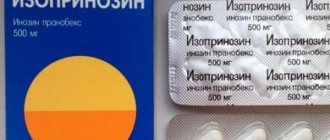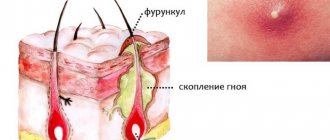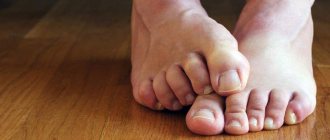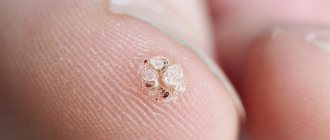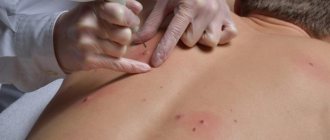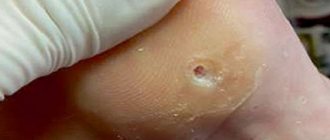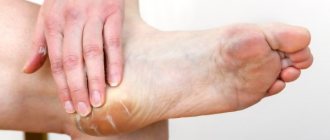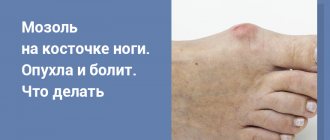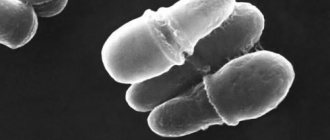Treating an abscess on a finger
First, disinfect the abscess. This can be done in any way:
- use a warm solution of salt, iodine and soda. Add a tablespoon of soda and salt to a glass of boiled warm water. Add 8-10 drops of iodine there and stir. Place the problematic finger in the resulting solution for 10 minutes, then tie it with a clean bandage;
- treat the abscess with a weak solution of potassium permanganate or peroxide. For processing, you can take any alcohol solution prepared from cologne, alcohol or vodka with water;
- treat the wound with iodine or brilliant green.
How to treat boils on hands
It is not recommended to self-medicate boils on the hand. The treatment process depends entirely on the stage of development and location of the abscess. During ripening, injections with antibacterial drugs are recommended. They also use levomekol ointment or ichthyol ointment. Apply a thick layer of ointment to the formation and secure it tightly with a gauze bandage. When carrying out such manipulations, within a day a purulent core will form in the center of the boil.
After opening, it is necessary to thoroughly treat the surface of the wound with alcohol or furatsilin. Then apply a compress with a special solution containing sodium chloride. The dressings should be changed daily until the pus is completely drained from the wound. You can remove the purulent core using tweezers only when it is completely separated. Removing an unripe stem will lead to additional infection. In order to avoid re-infection, before applying a new bandage, the affected area should be thoroughly disinfected with alcohol, brilliant green or any other product.
Treatment methods may also vary.
- To begin treatment, you need to know about the ability of boils to affect healthy areas. Sometimes self-healing is allowed, but only in cases where the size of the abscesses is small.
- We need to speed up maturation. Taking baths with potassium permanganate can help with this. Or apply hot compresses with manganese. When the rod is mature, it is strictly forbidden to take hot baths. This can lead to infection spreading into deeper layers of soft tissue.
- Often the cause of boils is disturbances in the functioning of the intestines, so triphala is prescribed. Probiotics can also help restore proper bowel function. It will also be useful to drink a complex of vitamins C and macroelements.
- Untreated boils are very dangerous and lead to serious complications. Therefore, in the most severe cases, the method of complete removal is used. Then stitches are applied. But, this is only in cases where the infection has deeply affected the tissue.
Traditional medicine methods are also used in combination with medications. Onion and garlic juice in equal quantities are mixed and applied in the form of compresses to the inflamed areas. Parsley leaves are also one of the effective means in the fight against such an unpleasant manifestation. The leaves are poured with boiling water, and then also applied in the form of compresses to the affected areas of the skin.
A compress of honey and narcissus roots helps open boils.
Vishnevsky ointment and fir oil are mixed in proportions 3:7. The resulting mass is applied three times a day under the bandage.
Compresses from henbane root are applied after opening to cleanse the surface of the wound from pus.
Such methods are unacceptable for treating children, as well as for people who have deep soft tissue injuries. In addition to all external procedures to eliminate an aesthetic defect, it is important to remember that an inflammatory process has begun in the body, which also requires treatment.
Narcissus root should be mixed with honey and used as a compress.
Treatment of finger abscess with ointments
After disinfection, begin treatment. To treat an abscess on a finger, use effective ointments:
- Vishnevsky ointment;
- Levomekol ointment;
- ichthyol ointment;
- Dioxidin ointment.
Fold the gauze into four layers and apply the selected ointment to it. Apply gauze with ointment to the problem area and tie with a bandage. Leave the bandage on for 12 hours, then carefully remove it. Remove the remaining ointment with a clean napkin and treat the wound with alcohol. It is best to do this procedure at night. Change the ointment dressings every 12 hours if you are at home. Continue treatment until the abscess breaks through.
It is worth noting
It is better to treat paronychia and felon in infants at home using safe folk remedies, because antibacterial ointments can cause diathesis and other allergic reactions.
However, you can use Vishnevsky ointment, which has no side effects or contraindications. It should be applied to a bandage and applied to the wound for several hours. This procedure should be repeated every other day until the abscess is completely healed. Recovery usually occurs quickly.
You can choose another method that is safe for the baby’s health, for example, using kombucha compresses, which quickly draw out pus and promote wound healing. However, it is better to discuss any of the above treatment methods with your doctor in advance.
How to anoint an abscess on your finger? Adequate treatment of local purulent-inflammatory processes (suppuration) on the skin can only be prescribed by a qualified doctor. There are often cases when surgical intervention is required and if you limit yourself to conservative therapy, you can significantly worsen your current health condition. Nevertheless, in this article we will consider the most common ointments for abscesses on the finger.
Treatment of an abscess on the finger with folk remedies
Treatment with folk remedies for an abscess on the finger helps speed up the process of maturation of the abscess. Pus will come out of it, and the wound will heal quickly. Use traditional effective recipes:
- baked onion Bake the onion along with the peel. When it becomes soft, cut out the middle, but do not damage the integrity of the onion. You will get a kind of ball with a hole. Place it on the injured finger and secure with a bandage. Leave for 3 hours. If the abscess does not break through, repeat the procedure. You can apply a thick layer of warm baked onion to the abscess and tie it with a bandage;
- a mixture of soap and onions. Take baked onion and grated laundry soap in proportions of 2 to 1. Make a paste from these ingredients, apply it to a bandage, apply to the sore spot and secure with a band-aid. Change the treatment bandage every 4 hours;
- honey cake. Helps draw out pus. Mix half a teaspoon of flour and the same amount of honey. Place the resulting cake on the problem area, secure it with a bandage and tie it with a bandage. Keep the bandage on for 9-12 hours.
How to care for your finger during treatment
Rules for caring for a finger that breaks near the nail:
- Do not puncture the purulent blister. Squeezing out pus is prohibited. You won't get rid of it completely; bacteria will continue to multiply. There is also a risk of blood poisoning if you suddenly pierce the skin deeper than you intended.
- You can make baths with chamomile infusion throughout the entire treatment. They help relieve inflammation and prevent the development of complications.
- Try not to disturb your finger. Do less typing on the computer and hold off on doing your homework.
- Pay close attention to hygiene to prevent contamination from worsening the infection.
- Use folk remedies only at the early stage of inflammation. In case of complications, consult a doctor and undergo treatment with antibiotics.
Surgical method for treating an abscess on a finger
If traditional recipes do not help, contact your surgeon immediately. The infection can cause headache, weakness, fever, and this is dangerous. The operation is performed under local anesthesia. The doctor will make a small incision in the skin, remove pus and dead tissue, and clean the wound with an antiseptic solution. Then a bandage is applied, it should be changed every day and the sore finger should be treated with products prescribed by the doctor.
Pay close attention to broken skin to prevent an abscess from occurring. Treat the smallest wound, otherwise it will turn into a large abscess. Remember: you can treat an abscess on your finger yourself in the early stages of its development. In severe cases, consult a doctor; improper self-treatment can cause serious complications.
An abscess on the finger is a common situation. People of all ages face this problem. With an abscess (or felon in medical parlance), not only the skin, but also deep tissues become inflamed.
Perhaps not everyone knows how to properly treat an abscess on a finger or toe. Delay or wrong actions can lead to disaster. In advanced cases, suppuration reaches the tendons and fatty tissue, and sepsis develops. Find out how to get rid of felon quickly and without complications.
Ointments for the treatment of joints - a list of the most popular drugs
What joint ointments are used if the knee joint, joints of the fingers and toes, or the shoulder girdle are bothering you? A list of what products are used to relieve pain and spasms of ligaments, cartilage and joints. What types of gels exist and how to use them correctly, do they help with severe pain. You can read about all this in this article.
Causes of pain
A joint can hurt not only due to age-related changes occurring in the joint tissues of the fingers, toes, and shoulder, but also from:
- Rapidly developing disease;
- Sprains of muscles and ligaments;
- Bruises, hematomas;
- Meniscus tears;
- Cracks, fractures.
Depending on the type of injury, a specific cream is used in each specific situation.
Since the causes of joint pain can be different, not every cream is suitable for alleviating the syndrome. The gel is selected depending on the cause that led to muscle pain, ligaments, cartilage diseases, large joints of the hands, knees, small joints of the fingers, what exactly needs to be treated and how.
Modern pharmacologists have developed the following types of gel:
- Anti-inflammatory.
- Warming and irritating.
- Anesthetic.
- Homeopathic.
- Chondroprotectors.
Causes
Provoking factors:
- onychomycosis – fungus on the feet and nails;
- violation of venous circulation;
- ingrown nail;
- improper manicure/pedicure;
- cuts, abrasions in the area of the nail fold, near the nail and fingertip;
- diabetes.
Note!
Often, abscesses on the fingers occur in people engaged in manual labor. While performing professional duties, it is easy to get hurt, get a splinter, scratch your finger, prick yourself with a fish bone, and so on. Dirt, dust, technical oils will complete the “dirty deed.”
An abscess on the toe appears:
- after an impact, injury to the skin with further penetration of dirt;
- as a consequence of an incorrectly performed pedicure when infection penetrates into wounds, cuts, under unprotected skin next to the nail plate;
- When wearing tight, uncomfortable shoes, not only an ingrown toenail can appear, but also an abscess if the integrity of the skin is compromised.
Ointment for boils and inflammation
How to anoint an abscess on your finger? Adequate treatment of local purulent-inflammatory processes (suppuration) on the skin can only be prescribed by a qualified doctor.
There are often cases when surgical intervention is required and if you limit yourself to conservative therapy, you can significantly worsen your current health condition.
Nevertheless, in this article we will consider the most common ointments for abscesses on the finger.
Main types of ointments for abscesses
Today there are no special problems with the choice of drugs for external use. The main types of ointments for abscesses:
- Pus-pulling agents (Ichthyol ointment, Syntomycin). They are effective at the initial stage of the disease, when the formation of a boil is observed - a purulent lesion on the skin.
- Antibiotic ointments (Levomekol, Tetracycline ointment, Oflocaine). They help cleanse the pathological focus on the skin from pus and cope with microorganisms that provoke inflammation.
- Healing ointments (Zinc, Balsamic Liniment according to Vishnevsky). Accelerate the recovery process and prevent re-infection of the wound.
Before applying any medicine to an abscess on your finger, you should consult a specialist.
Zinc ointment
It is necessary to use Zinc ointment at the healing stage after resolution of purulent inflammation on the skin. When used correctly, it ensures a rapid process of restoration of affected tissues. It is recommended to apply the ointment to the area of inflammation up to three times a day. The full course of treatment is determined individually.
What pharmacological action does the drug have:
- Antiseptic.
- Knitting.
- Drying.
If hypersensitivity to zinc oxide is noted, this drug should not be used in local therapy. It is strictly not recommended to use it in the acute stage of purulent inflammation, when there is still pus in the skin.
Zinc ointment can be used with other medications for external use (for example, antibacterial drugs). As a rule, improvement occurs within a few days.
There are no clinical data on drug interactions with other drugs.
Zinc ointment for abscesses is available at a price of 25 rubles.
Source: //MoyaKoja.ru/lechenie/antibiotiki/maz-ot-naryvov.html
Symptoms and stages
There are several stages of the inflammatory process:
- after infection penetrates into the upper layers of the epidermis, the skin turns red, swells, painful sensations and itching appear;
- the spread of the inflammatory process into the deep layers of the dermis is accompanied by the formation of a strip or bubble with pus inside;
- throbbing, twitching pain appears;
- the finger stops bending, the affected joint feels hot and hard to the touch;
- when fatty tissue and tendons suppurate, health worsens and the temperature often rises.
Types of felon:
- cutaneous and subcutaneous;
- periungual;
- subungual;
- tendinous.
Where are abscesses located?
Abscesses most often appear in areas where hair is located. They do not occur in the areas of the feet and palms. Inflammation occurs due to the fact that Staphylococcus aureus or white staphylococcus enters the hair follicle. This bacterium activates the process of inflammation, which causes tissue suppuration.
Boils on the elbows appear mainly after hypothermia or heavy loads on the elbow joints, stressful situations and a lack of vitamins. Most often, it manifests itself in early spring, when almost everyone suffers from vitamin deficiencies. At first it is a small, painful boil. When you palpate it, you can feel a small hard ball inside, which grows more and more every day.
Another location is the fingers. There is also hair on the fingers that can become inflamed. Interdigital furunculosis occurs for several reasons:
- lack of hygiene,
- small scratches, which are very common on the hands, are where pathogenic microbes penetrate.
If the body is sufficiently saturated with vitamins, abscesses do not appear
Treatment methods
How to treat an abscess on a finger near the nail? In the first stages of the disease, conservative treatment under medical supervision is recommended. Severe, advanced cases require surgical intervention.
At the first signs of suppuration of soft tissues, swelling, mild pain, begin treatment:
- prepare a bath with potassium permanganate. Dissolve a few crystals in warm water until a light pink tint is obtained, and lower the sore finger. Carry out the procedure for 5–10 minutes;
- gently pat the skin dry. Fold the bandage, lubricate it with Vishnevsky ointment, Levomikol, Dioxidine ointment, and apply it to the inflamed area. These drugs actively accelerate the maturation of the abscess, after which pus flows out of the wound;
- bandage the sore spot, but not too tightly. See what the results are in a day or two.
Important!
If you find not only swelling and redness of the tissues on the epidermis, but also small blisters, do not do anything on your own. Perhaps this is a fungal disease or the herpes virus is active on the skin. Treatment methods will be different. Improper actions contribute to the penetration of fungi into new areas.
Be sure to visit a surgeon if:
- your health has worsened;
- twitching pain appeared;
- the finger is more swollen;
- the skin is red;
- Pus accumulates under the nail, in the subcutaneous tissue or under the nail fold.
MosPharma antiseptic
Good day to all!
I recently became acquainted with such an unpleasant thing as PANARICIUM . And I never thought that a harmless swelling on a finger could lead to dire consequences.
It all started with the fact that my ring finger turned red near the nail, began to hurt , swelling and there was no obvious suppuration yet. It seems like I didn’t pull off hangnails; the cause of the abscess could have been small wounds, cracks near the nail, through which the infection got inside.
If I had immediately turned to a surgeon with this problem, there would have been no operations, but instead I began to read articles on the Internet: my finger breaks, what should I do? Panaritium treatment at home...
Sore finger near the fingernail
There were many recipes on the Internet to fix the problem; they recommended steaming your finger in warm water with soda, salt, applying coltsfoot (which you should look for in winter), applying onions, lubricating with iodine and brilliant green.
There was a choice of ointments: ichthyol ointment or Vishnevsky ointment.
Then I went with my problem to the pharmacy, showed my finger there and the pharmacist advised me to use ichthyol ointment, and that’s how I got it.
Full name:
- Ointment for external use ICHTHYOL / ICHTAMMOL MosPharma 20% 30 g
Anti-inflammatory agent for topical use
Price – 83 rubles
Place of purchase: pharmacy for the thrifty
INSTRUCTIONS FOR USE
Compound:
Active substance: Ichthammol (ichthyol) 10.0 g or 20.0 g
Excipient: Vaseline 90.0 g or 80.0 g
Description: Dark brown ointment with a peculiar odor.
Pharmacotherapeutic group: Anti-inflammatory agent for topical use.
Pharmacological properties: Anti-inflammatory agent, has antimicrobial (bactericidal against Staphylococcus aureus and Streptococcus pyogenes), keratoplasty effect. Accelerates the maturation of boils.
Pharmacokinetics: Absorption is low.
Indications for use: Erysipelas, eczema, pyoderma (including furunculosis).
Contraindications: Hypersensitivity to the drug.
Use during pregnancy and lactation: During pregnancy and lactation, the use of the drug is indicated if the potential benefit to the mother outweighs the possible risk to the fetus.
Special instructions: Do not allow the ointment to come into contact with mucous membranes or eyes. After applying the ointment, wash your hands thoroughly to prevent the ointment from getting into your eyes, nose, and mouth.
Directions for use and dosage: Externally. Apply a thin layer to the affected areas of the skin 1 – 2 times a day. If necessary, use a bandage.
The duration of the course and the specifics of the treatment regimen (for both children and adults) must be agreed with the doctor.
Side effects: Local allergic reactions are possible. If any of the side effects indicated in the instructions get worse, or you notice any other side effects not listed in the instructions, tell your doctor.
Interaction with other drugs: Incompatible with solutions of iodide salts, alkaloids, and heavy metal salts.
Effect on the ability to drive vehicles and other mechanisms: No effect.
Release form: Ointment for external use 10% and 20%. 25 g in orange glass jars; 30 g in aluminum tubes. Each jar or tube, along with instructions for medical use, is placed in a box made of cardboard.
It is allowed to place jars or tubes with an equal number of instructions for use in a group package.
Packaging for hospitals.
1.5 kg in jars with polyethylene terephthalate lids or polyethylene terephthalate jars with polyethylene lids; 15 kg in polyethylene bags, the bags are placed in metal cans.
Storage conditions: In a place protected from light, at a temperature not exceeding 20 °C.
injure in a place inaccessible to children.
Shelf life: 5 years. Do not use after the expiration date stated on the packaging.
Conditions for dispensing from pharmacies: Without a prescription.
MANUFACTURER
The ointment is produced in Moscow at the MosPharma plant.
BEST BEFORE DATE
Quite large, a full 5 years from the date of manufacture. It is indicated on the box.
Duplicated on tuba.
It is recommended to store the ointment at a temperature not exceeding 20 °C.
BARCODE
I checked it for authenticity.
Barcode: genuine , country of origin: Russia
TUBE WITH OINTMENT
A metal tube with a white plastic cap attached to it using a thread.
There was control of the first opening.
(The photo was taken right after I bought the ointment. I wanted to write a positive review that it helped me, but...)
It was necessary to make a hole in the tube with the sharp end of the cap, and then the ointment would come out free.
CONSISTENCY
The ointment is like melted chocolate, viscous and sticky.
FRAGRANCE
Unpleasant, smells like railroad, asphalt, tar. I really don't like this smell.
COLOR
Dark brown, even scary. The ointment gets very dirty and stains everything around. When I applied it to my finger, the neighboring finger also got dirty with it, and when I lay down on the bed, I accidentally stained the pillowcase on my pillow. I regretted getting involved with this dirty ointment. Then she began to bandage her finger with gauze.
Ichthyol ointment and periungual panaritium
APPLICATION
I applied this ichthyol ointment to the site of the abscess for two days, 2 times a day, during which time it stained everything around me.
RESULT from using ichthyol ointment
I took the photo when I was already sitting in line to see the surgeon at the clinic with acute pain, they gave me a coupon without any problems. The finger has festered, pus is already visible through the skin, it is even more swollen, red and white, the situation has become much worse. At the same time, the pain was not very strong, only when I touched my finger, then it hurt. The finger did not ache or bother me at night.
The surgeon was an older woman. She looked at her finger and said that I came late. She also scolded me for using ichthyol ointment; it couldn’t be used and I couldn’t hover my finger either (I didn’t do that).
Then I was invited to the next office for an operation. They asked me to lie down on the operating table and injected me with an anesthetic. Oh, how it hurt! The most painful part of the operation is enduring the injection. They even gave me two injections, I just don’t know why the second one.
And then I didn’t feel much pain anymore, the finger was severely cut, the pus was cleaned out, it was treated, Levomekol ointment was applied and it was bandaged. The operation lasted about 5-10 minutes.
The doctor told me to come tomorrow for a bandage, and when I get home, take a painkiller and apply ice from the refrigerator.
As a result, I was riding the bus home and noticed that my finger was bleeding , all my gloves were stained with blood, and I put a plastic bag on my hand. My finger bled very badly the whole day, it hurt, ached, and made it difficult to sleep.
In the morning I arrived for a dressing change; the first dressing after the operation was the most difficult. We soaked the bandage with chlorhexidine, since everything had dried up. I didn’t have breakfast this morning and even managed to faint. Since then, I went to dressings well-fed and always had breakfast in the morning.
On the third dressing, they told me to soak my finger in alcohol and hold it for 10 minutes; it stung a lot, but it didn’t look so bad.
I went to dressings after the operation for 3 days, and then there were holidays and they told me to bandage at home. This was difficult for me, because seeing your finger mutilated is very unpleasant.
They gave me instructions on how to do everything correctly.
I bought everything I needed at the pharmacy. I didn’t wash my hand in potassium permanganate, I just kept my finger in salicylic alcohol for 10 minutes, then lubricated it with fucorcin (it’s pink), applied Levomekol ointment (the nurse told me that this ointment is the best of all), and bandaged it with a sterile bandage.
SCARY PHOTOS
I'll show my finger a week and 1 day after the operation . I came for another dressing, they said that the wound had dried up, not to treat it anymore and to walk without a bandage at home so that the swelling would go down and it would dry out further. For some reason they didn’t put any stitches, I’m afraid the finger will remain so ugly, but they said it will heal.
Finger 3 weeks and 5 days after surgery
A couple of years later, the finger never became the same; the scar from the operation remained for life.
I know that the review does not have the most pleasant pictures, but suddenly if someone encounters a problem like mine, they will know what they have to endure, experience and see.
RESULTS regarding ichthyol ointment
Advantages:
1) Affordable price;
2) Most likely available in any pharmacy and available without a prescription.
Flaws:
1) Made it worse, did not help with an abscess on the finger near the nail;
2) Disgusting aroma;
3) It dirty everything around.
Conclusion. I do not recommend purchasing ichthyol ointment on your own without a doctor’s recommendation. She didn't help me with panaritium. If everything is bad with your finger, it breaks out, then it is better to consult a surgeon as soon as possible, but be prepared for such consequences, the doctor will not regret cutting your finger / performing an operation.
And at the beginning of the disease, you can try to treat the wound with an antiseptic , for example, miramistin, and then apply fucorcin , dry it and apply levomekol ointment on top, bandage the finger with a bandage.
All the best and good health!
Source: //irecommend.ru/content/naryvaet-palets-vozle-nogtya-na-ruke-gnoi-chto-delat-ik-komu-obratitsya-panaritsii-na-palts
Abscess on a child's finger
Panaritium is quite common in children of all ages. Causes:
- wounds;
- cuts;
- splinters;
- failure to comply with hygiene rules.
With weakened immunity and lack of treatment, the infection quickly spreads deep into the tissues. Listen to your child’s complaints of pain and take action immediately.
How to proceed:
- prepare a bath with herbal decoction. Brew chamomile, calendula, St. John's wort. Let the child hold the sore finger in the healing liquid for 20 minutes;
- a bath with potassium permanganate is effective;
- wipe dry, treat the affected area with brilliant green;
- after a few hours, check whether the inflammation has subsided;
- Is the tumor not shrinking? Apply a compress with Vishnevsky ointment. The smell is unpleasant, but the composition is active, quickly heals the wound, destroys pathogenic bacteria, accelerates the maturation of the abscess;
- the next morning, check the condition of the sore spot. There are no visible improvements, the tissues swell further, is there severe pain? Immediately go for a consultation with a surgeon;
- the doctor will tell you how to act in your case.
Important! Do not self-medicate.
In the first day you can cope with a mild form of the disease. If there are no visible results, you cannot do without the help of a doctor.
Most abscesses appear due to insufficient attention to minor damage to the skin. Follow simple rules - and you will prevent a tiny wound from turning into a panaritium.
Recommendations:
- promptly treat scratches, cuts, and splinter removal sites with disinfectant solutions. Effective: alcohol, hydrogen peroxide, iodine, brilliant green;
- Have you injured your finger or toe while hiking? Attach a clean leaf of plantain or coltsfoot;
- during a country trip, the mini-first aid kit should always contain antiseptics, Vishnevsky ointment or Levomikol, local antibiotics, bandage, cotton wool;
- wash your hands thoroughly, do not allow dirt to get into scratches or wounds;
- trim your nails carefully, leaving sufficient length of the nail plate to protect delicate skin;
- If you get pricked with bones while cutting fish, immediately steam your finger in a solution of potassium permanganate or chamomile infusion. Lubricate the injection site with green paint;
- remove the splinter in compliance with antiseptic rules, treat the sore spot with alcohol before and after the procedure. Couldn't get the splinter out on your own? Be sure to go to a surgeon. The deeper the splinter goes, the more inflammation can develop.
An abscess on a finger or toe is a serious nuisance. Now you know preventive measures and effective methods of combating felon. Be healthy!
From the following video you can learn some more useful tips for treating an abscess on your finger:
Every person's hands are exposed to a huge amount of trauma and damage every day. If the skin of the palms is denser and not too vulnerable, then around the fingers it is thin and susceptible to microbial attacks. That is why the question of how to treat an abscess on the finger near the nail is relevant. The treatment process largely depends on the location of the boil and associated pathologies.
Home Recipes
Traditional medicine successfully helps cope with inflammatory processes: both in combination with medications and independently. At home you can use the following folk recipes:
- Prepare a chamomile bath . Brew chamomile (sold at the pharmacy), cool the decoction to a comfortable temperature, and dip your finger in it. This must be done daily until the inflammation goes away.
- Bath with potassium permanganate . Dissolve several crystals of potassium permanganate in warm water until pink. Lower your finger for 5-10 minutes. This will help reduce the inflammatory process. Afterwards, it is recommended to make a compress with anti-inflammatory ointment (Levomekol, Dioxidin and the like).
- Baked onion. Bake the onion in the oven, whole. Knead. Grate laundry soap and mix the ingredients in equal proportions. Make compresses from the pulp, change every 4 hours.
- Vegetables and aloe. Make a paste of fresh beets, carrots and onions. Add a few drops of aloe juice to it. The compress needs to be changed every 4 hours.
- Iodine. Dilute 10 drops of iodine in a glass of boiled water, add 1-2 tablespoons of salt, stir. Keep for 15-20 minutes. Helps get rid of pus.
- Plantain or coltsfoot . Pluck a plantain leaf (coltsfoot is also suitable), clean it of dust, wrap it around the sore finger, and secure it. You can grind the leaves into a paste and make compresses from them.
- Aloe . Cut a leaf from homemade aloe and cut it in half. Apply to the inflamed area of the finger, secure with gauze, bandage or plaster.
- Honey and flour . When your finger breaks out near your fingernail, you can make a honey cake by mixing natural honey and flour in approximately equal proportions. Bandage the mixture to your finger, keep it for 10 hours, change if necessary.
- Raw potatoes . Grate it on a fine grater, place it on gauze, and bandage it to your finger. Change the potato compress regularly; it helps draw out pus and relieve inflammation.
Remember that folk remedies are effective only for mild abscesses and in the initial stages. In severe conditions, medication and medical intervention cannot be avoided.
Types of boils
When acute inflammation occurs around the nail, we are talking about paronychia. This option occurs if a burr is torn off or another mechanical injury occurs. Bacteria have penetrated deep into the layers of the skin and cause purulent inflammation of the periungual fold.
Usually everything ends in an abscess only in the superficial layer of the epidermis. Symptomatically this is accompanied by:
- Redness.
- Pain.
- Pus gradually forms, which rises higher and higher and becomes visible through the surface layers of the skin.
It is much worse if the abscess has formed under the nail plate. The pain becomes pulsating and unbearable; the entire area near the nail is hyperemic. The outcome of the process usually consists of a breakthrough of pus, and then the nail peels off.
Useful video
How to treat a purulent abscess on the finger near the nail:
Boils (boils) are dermatological diseases of a purulent-necrotic nature. First, the inflammation covers the hair follicle, then gradually spreads to the surrounding tissues and sebaceous glands. Ulcers can form on any part of the body (they do not occur only on the palms and soles), and a boil on the arm is no exception. It can be localized on the elbow, accompanied by intense pain and cause discomfort during movement.
Boils often appear on the finger, but it is important to distinguish a boil from a panaritium. A boil always forms in the hair follicle, on the outside of the hand. Panaritium affects mainly the palmar part of the hand and the periungual areas.
The development of an abscess is provoked by a staphylococcal infection, which under normal conditions is part of the skin microflora. The presence of unfavorable factors leads to the rapid proliferation of these opportunistic bacteria and the result of their vital activity is suppuration.
There are many factors for the development of boils:
- decrease in the body's immune forces;
- chronic infections;
- endocrine and hormonal pathologies;
- microtraumas of the skin through which bacteria penetrate;
- increased sweating due to lack of hygiene;
- hypothermia;
- regular contact with fuels and lubricants and much more.
It is not difficult to cure a single boil on a finger; it is usually treated at home. But it is quite difficult to cope with multiple lesions (furunculosis), which often becomes chronic. This requires antibiotic therapy, immunostimulants, vitamin complexes and physiotherapeutic procedures.
Before treating interdigital furunculosis, you should definitely consult a doctor.
Treatment tactics
Treatment depends on the type of suppuration and what symptoms accompany it. This is a general increase in temperature, symptoms of intoxication, and a history of manifestations of diabetes mellitus.
When providing first aid, it is important to prevent the development of complications. To do this, you must follow the rules:
- Under no circumstances should you open an abscess on your finger yourself. The pus must be completely removed; this is difficult to do without the help of a doctor. When puncturing, there is a risk of spreading the infection into deep-lying tissues, which will lead to a septic process.
- At the initial stage of the process, it is allowed to make baths with table salt, soap or chamomile decoction. It is recommended to steam your finger in them; the procedure is repeated several times a day. After that, thoroughly dry the limb and prevent it from becoming contaminated.
- If pus has already begun to form, a compress of aloe vera or onion can be applied to the abscess area.
In this way, the tactics for treating an abscess on the finger are formed. There are surgical methods for opening suppuration near the nail, as well as folk remedies.
If self-treatment does not give any effect for 3 or more days, you should urgently consult a doctor.
Traditional therapy
They resort to the help of doctors if the patient is not able to cure an abscess on his finger in a short time on his own. Or suffers from conditions in which tissue trophism is severely impaired:
- Diabetes.
- Immunodeficiency.
- Metabolic disorders.
- Recent infectious diseases.
- With accompanying boils in another part of the body.
- Severe vascular atherosclerosis.
Unfortunately, patients who do not suffer from concomitant pathologies usually see a doctor late, when the process has spread. It is especially dangerous when the affected area is located under the nail plate. Dense tissue does not allow pus to come out, this leads to expansion of the process and loss of the nail.
In any case, surgery is performed. Under local anesthesia, the doctor makes an incision and squeezes out all the purulent contents. The postoperative wound is washed with antiseptics and a sterile bandage is applied. Treatment of the wound and change of dressing material are carried out for several more days in a row. This is usually enough to get rid of the abscess.
Antibacterial drugs are prescribed in difficult cases, with the spread of the process and fever. A test for individual sensitivity to antibiotics is required. Self-medication without a doctor's prescription can cause enormous harm; in addition, not all drugs have an effect; they can also cause dysbacteriosis.
If a patient has an abscess on his toe, it makes sense to prescribe a short course of antifungal medications after surgery. The foot and toes are extremely vulnerable to the penetration of fungi; this situation must be foreseen.
Unconventional treatment for abscess on a finger
- Make a dressing from mashed baked onions and crushed laundry soap. Mix the ingredients equally, apply to the wound and wrap with a sterile bandage. Change the bandage every 3-4 hours.
- From the very beginning of the disease, take a glass of warm boiled water, add 10 drops of iodine, 1 tbsp. l. salt and soda. Keep your finger in the resulting liquid for 15-20 minutes.
- To eliminate an abscess near the nail, take equal parts of carrots, onions, beets, and a few drops of aloe. Grate on a fine grater or pass through a blender. Mix thoroughly and make a compress.
- Heat 50 grams of honey and ground laundry soap in a water bath, mix, add flour. Make a cake from the resulting mass and apply to the affected area.
- A poorly done manicure can cause problems. If your finger is narwhal, a mixture of chamomile, calendula and string will help. Immerse your finger in the resulting herbal mixture for at least 20 minutes. Repeat the procedure several times with an interval of 3 hours.
- Grate a raw potato tuber, apply and bandage. It has a pronounced analgesic effect and cleanses wounds.
- If there is an abscess under the fingernail, nettle tincture will be effective. To prepare it, you will need to make a composition: pour young nettle leaves with vodka, leave for 2 weeks in a well-lit place. Moisten sterile gauze in the resulting composition, apply to the suppuration and wrap with polyethylene. Within a short time, a breakthrough of pus should occur.
Knowing how to remove pus in the area of fingers and toes, you can avoid dangerous complications. The same applies to childhood. Children are prone to injuries due to improper nail cutting and neglect of hygiene. It is difficult to rid a child of an abscess on his finger on his own and you may miss the moment of general infection. It is better to consult a doctor immediately. After examination by a doctor and by agreement, you can try using folk remedies. They are not much different from measures for adults, only they are used in a more gentle form.
For abscesses before surgery, Vishnevsky ointment and Levomekol help well.
Apply the ointment to the skin at the affected area, be sure to remove any excess. You need to put a bandage on top. If the circumstances are successful, no additional manipulations with the child’s hands will be necessary. Understanding how to get rid of pus in the skin of the fingers using folk and traditional methods, everyone will be able to choose a method of treating an abscess on the finger for themselves. The main thing is to understand that delay is dangerous and if the condition worsens, you should immediately contact a specialist. Only he can give the right advice on how to cure a boil, what to do if your finger breaks out further.
Children and adults experience abscesses on the fingers near the nail
. Hands come into contact with water and different things every day. The skin on the hands is thickened, and the fingers on the outer phalanges are protected by dense nail plates. But it is very difficult to completely eliminate injury to the skin of the hands.
Pathogenic microbes easily enter the skin through small, unnoticeable scratches. After some time, a certain area becomes inflamed and suppuration appears.
You should not ignore such a problem as an abscess on your finger near the nail; folk remedies will tell you what to do.
There are many proven recipes that will help you quickly eliminate this disease at home.
.
An acute inflammatory process on the finger near the nail is medically called paronychia
.
If a person has a weak immune system, then when the skin is damaged, staphylococci, fungi, and streptococci enter the tissues of the fingers. They cause a purulent inflammatory process.
Provoking factors:
- fungal diseases on the fingernails;
- unsuccessful manicure;
- cuts near the nail fold;
- poor circulation inside the veins;
- ingrown nail;
- consequences of diabetes.
Whatever the cause of paronychia, it will be characterized by the following symptoms:
- Redness of the skin on the problem finger.
- Unexpressed pain during the formation of edema.
- Detection of pus in the affected area.
- Gradual increase in edema and phalanx.
- Increasing pain of a pulsating nature.
- Limitation of finger movement, sensation of warmth around it.
- Deterioration in health: fatigue, headache, increased body temperature.
Diagnosing paronychia is not difficult at all, even for those who do not have deep knowledge in the field of medicine. Signs of an abscess on the phalanx appear quite clearly. And it’s difficult to confuse an abscess with something else; it matures intensively.
In some cases, when contacting a specialist, an x-ray of the limb may be prescribed. This will make it possible to identify the severity of the disease and the possibility of complications.
An abscess in advanced form is very dangerous
. The finger may completely or partially lose its function if the purulent inflammatory process spreads to the tendons, bone tissue, or joint of the finger. In severe cases, the hand and forearm may be affected.
If you have diabetes, the following complications may occur:
- Sepsis
is a very dangerous condition; without qualified timely assistance it can lead to death. - Phlegmon of the hand
is an acute purulent inflammation of the cellular tissue of the hand. - Tenosynovitis
is a purulent inflammatory process in the tendons. This condition causes long-term loss of movement in the affected finger. - Osteomyelitis
- this complication causes damage to bone tissue by pus. If surgical intervention is not done in a timely manner, complete amputation of the finger may be necessary.
Drug treatment
Anti-inflammatory ointments will help relieve suppuration of the finger at the nail. You can buy them at the pharmacy without a prescription. If a finger on your hand breaks out near the nail, most doctors prescribe these medications:
- Levomekol. Antimicrobial ointment, relieves inflammation, easily penetrates tissue.
- Vishnevsky ointment. Antibacterial balsamic liniment that accelerates regeneration and relieves inflammation.
- Dioxidine. A broad-spectrum antibacterial agent, prescribed only to adult patients.
If your finger near the nail is seriously festering, and the inflammatory process is accompanied by general weakness and fever, the doctor may prescribe antibiotics. They are taken orally (orally or by injection) and are based on penicillin or cephalosporin. Can be assigned:
- Ampicillin.
- Chloramphenicol.
- Oxacillin.
- Erythromycin.
Your doctor will tell you how to treat serious inflammation. You cannot take antibiotics on your own. The dosage and method of administration are also determined individually.
Boils on the hands of children
Most often, boils appear in children in the spring and summer, when it is already warm outside and the conditions for the development of bacteria are most favorable. Plus it's time to walk in the fresh air. Hands are washed less often and are damaged more often due to extreme childhood activity. A furuncle in a child most often chooses the fingers and interdigital areas as its location.
Manifestations:
- a nodule of one centimeter in diameter forms on the body,
- Most often, the appearance of boils is accompanied by painful sensations,
- when opening the boil, the rod is visible,
- after rejection a wound is formed,
- often the whole process is accompanied by sleep disturbances, increased body temperature, nervousness,
- if the ulcers are located on the face, there is a possible risk of further infection and penetration of the infection into the skull, which in turn leads to meningitis,
- when several ulcers appear between the fingers at once, this condition is called interdigital furunculosis.
It is important to remember that children cannot treat boils on their own without a doctor’s examination. In children, the phenomenon of interdigital furunculosis is observed much more often. Since they come into greater contact with contaminated objects, their skin is more delicate and therefore more easily injured, and the strength of the fragile immune system is not enough to cope with the huge number of bacteria that attack the body every second. Plus, hormonal changes begin in adolescence.
In children, furunculosis occurs with a significant deterioration in general health. At the same time, one encouraging fact is that it goes away faster than in adults and much less often develops into a chronic disease.
Depending on the degree of development, interdigital furunculosis and any other part of the body has several stages.
- Simple. When a single boil appears on the body. This stage is characterized by enlargement of the lymph nodes, which indicates the development of inflammation in the body. The pain is moderate. Ulcers appear no more than twice a year.
- The middle stage is characterized by the appearance of single boils or groups of boils up to three times a year. Lymph nodes enlarge, body temperature rises, and symptoms of intoxication appear on the face.
- During the severe stage, recurrent boils constantly appear on the body. Severe intoxication.
The general strategy for treating boils throughout the body is the same. The algorithm for carrying out therapeutic measures for children and adults will be absolutely no different. At the initial stage, when the boil has just appeared, it needs to be treated with antiseptic agents, such as alcohol, brilliant green, iodine, etc. If the pain is unbearable, then the skin around the affected area is injected with an anesthetic. Interdigital furunculosis, like any other, is treated with antibiotics. They are used as blockades. They are used to prick the skin around the inflammation. In the early stages, such a move can have the opposite effect.
After ripening, bandages with drugs are applied that will help speed up the process of opening and rejection. Doctors strictly prohibit squeezing out the rod. This can lead to infection and cellulitis. After the pus has gone, the wound surface is treated with antiseptic agents and healing compresses are applied. In combination with these actions, antiviral drugs and vitamins are prescribed.
High temperature often accompanies the development of a boil
